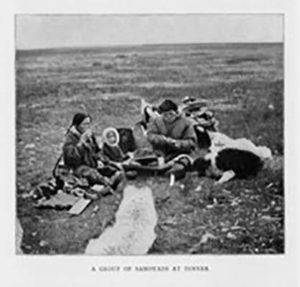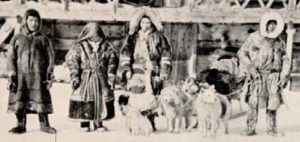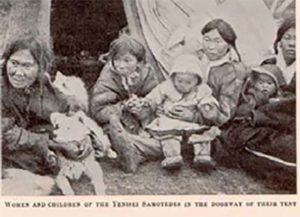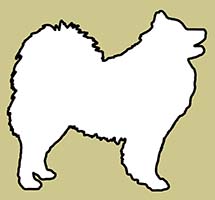Samoyeds: Then & Now
by Helen Newman
First published in “The Yapper” 2003
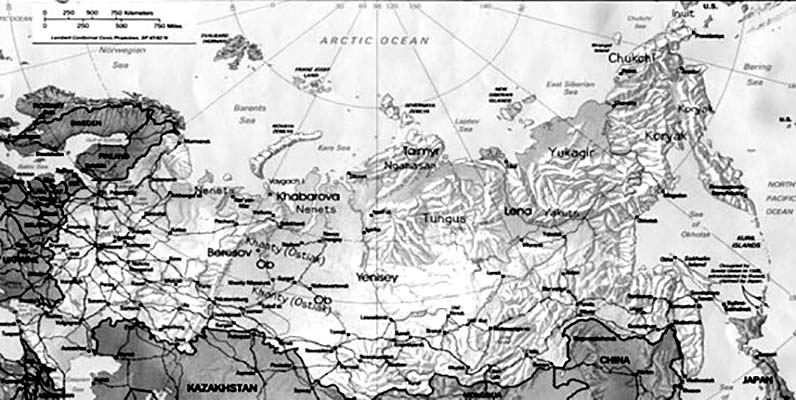
To better understand the origin of Samoyed dogs, one needs some background/history of the people and area the dogs are believed to have originated. What we think of today as “Samoyeds people” were not originally called that term, but it was a term the Russians used to group people whose language was the same or very similar. The Samoyeds of the tundra were of 3 groups: Nganasan, Nenets and Enets (Entsy). The Nganasan lived on the Taimyr peninsula, which lies between the Lena and Yenisey Rivers. The Enets (Samadu) were their neighbors to the west, near the lower Yenisey and Taz Rivers. The third group, Nenets (Samoyeds or Yuraks), lived in the largest territory on both sides of the Ural Mountains, going from forest and the Arctic coast into the Kanin, Gydan and Yamal peninsulas.
The Nganasan used dogs as a means to hunt geese that were molting. And it was not till the mid 19th century did reindeer breeding become important to this group of Samoyed people. Their reindeer were “wilder”, and roamed farther in search of food, which meant their dogs watched the reindeer 24 hours or they would be lost. The type of dogs they used to help control their reindeer are described as “short-legged, fluffy dogs of the layka breed”. So dogs were used in herding but what they actually looked like was not something I actually could find in the literature I searched.
The Enets before the Revolution (1917) were called Khantayka and Karasin Samoyeds and they used reindeer for transportation but no mention was made of dogs for any use in the history books and literature. There were Nenets that were relocated to Novaya Zemlya and Vaygach Islands by the Russians, so they (the Russians) could claim the land, and these relocated Nenets did adopt the ways of the Russians in using dogs for transportation. The Nenets that were not relocated main use of dogs was for controlling their large herds of reindeer.
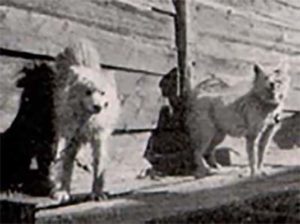
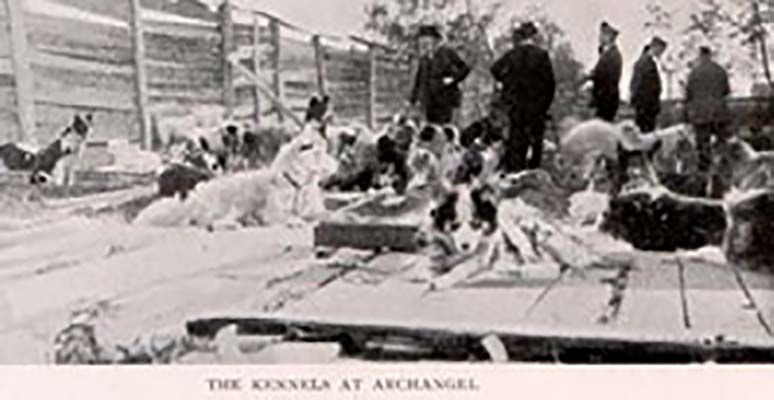
Another group of people that were neighbors to the “Samoyed people” and are mentioned frequently in the explorer diaries’ and in historical writings about the people of Siberia that did use dogs multiple ways were the Khantys (Ostiaks). This group of people occupied the area from the mouth of the Ob and the northern Urals, up to where the Ittyoh joins the Ob and east into theheart of Siberia. The Khantys did adopt the nomadic reindeer culture from the Nenets, and used their dogs for controlling their herds. But they also used dogs for transportation in the winter and in the warmer seasons the dogs were used to pull their boats up river.
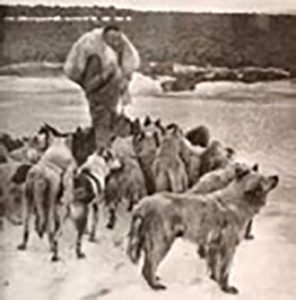 During a 15-20 year span, 1893 to 1910, give or take a few years, many explorers wanted tor each the North Pole and the South Pole. Many of them decided the use of dogs, pulling sledges, would be the best means to transport their supplies. The dogs needed for these expeditions needed to be acquired and many came from the land of Siberia, but some (depending on which expedition) were obtained from Greenland. Nansen, Jackson, Wellman, and Abruzzi were explorers that set to reach the North Pole with the aid of dogs. Borchgrevink (with Bernacchi), Scott and Shackleton were trying to reach the South Pole with the use of dogs. All of these explorers, except Jackson, used the same dog agent to procure their dogs for them. This dog agent was Alexander I. Trontheim.
During a 15-20 year span, 1893 to 1910, give or take a few years, many explorers wanted tor each the North Pole and the South Pole. Many of them decided the use of dogs, pulling sledges, would be the best means to transport their supplies. The dogs needed for these expeditions needed to be acquired and many came from the land of Siberia, but some (depending on which expedition) were obtained from Greenland. Nansen, Jackson, Wellman, and Abruzzi were explorers that set to reach the North Pole with the aid of dogs. Borchgrevink (with Bernacchi), Scott and Shackleton were trying to reach the South Pole with the use of dogs. All of these explorers, except Jackson, used the same dog agent to procure their dogs for them. This dog agent was Alexander I. Trontheim.
Trontheim, under the orders of Nansen, was to obtain Ostiak dogs (Khantys) for his try to the North Pole (Farthest North). In anuary 1893, Trontheim was in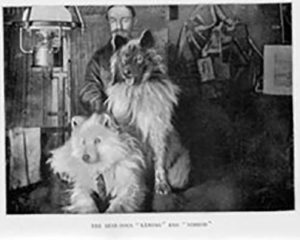 Berezoff Siberia at the time the Ostiaks and Samoyed people were gathered there to pay their fur taxes. He saw many “fine Ostiak sledge dogs” and purchased the dogs Nansen requested at this location. These dogs were transported to the Fram, in port at Khabarova in the Yugor Strait. Nansen states in his diary that he was very pleased with the dogs provided to him by Trontheim and that their coats were double coated, and when wet the undercoat protected the dog from any wetness. He also describes the dogs as “long-haired, snow-white, with up-standing ears and pointed muzzles. With their gentle, good natured looking faces..” Nansen states that all but 4 of the obtained dogs were neutered and the bitch he brought from home, Kvik, was intact. So all descendents were from these 5 dogs. All the dogs Nansen used with the sledges in his run to the pole did not return. But he did leave 6 pups and a pregnant bitch (Sussie) that whelped 12 pups behind on the ship. One of these (Grasso) was given to the explorer Abruzzi.
Berezoff Siberia at the time the Ostiaks and Samoyed people were gathered there to pay their fur taxes. He saw many “fine Ostiak sledge dogs” and purchased the dogs Nansen requested at this location. These dogs were transported to the Fram, in port at Khabarova in the Yugor Strait. Nansen states in his diary that he was very pleased with the dogs provided to him by Trontheim and that their coats were double coated, and when wet the undercoat protected the dog from any wetness. He also describes the dogs as “long-haired, snow-white, with up-standing ears and pointed muzzles. With their gentle, good natured looking faces..” Nansen states that all but 4 of the obtained dogs were neutered and the bitch he brought from home, Kvik, was intact. So all descendents were from these 5 dogs. All the dogs Nansen used with the sledges in his run to the pole did not return. But he did leave 6 pups and a pregnant bitch (Sussie) that whelped 12 pups behind on the ship. One of these (Grasso) was given to the explorer Abruzzi.
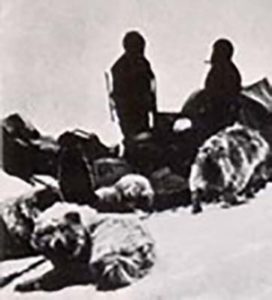 The American explorer, Wellman (1898-1899) also requested Trontheim to procure his dogs from the Ostiak people for his try to the North Pole. The Italian explorer, Abruzzi (Polar Star), acquired 121 dogs from Trontheim who obtained the dogs from Tobolsk located in Siberia. Abruzzi makes these statements concerning the dogs: “ they are varied in color, white, white and black, brown and gray with pointed ears, up and curled tails with deep chests” . Another interesting point he makes is this lot of dogs were already trained to pull sledges, something the dogs that Nansen had were not. Abruzzi describes the superior sledge types as follows:” short haired, resembling wolves to the long-haired dogs of various races. Greater strength and withstanding the weather”. The surviving dogs of the sledge expedition and an additional eight dogs were spared (4 males, 2 females and 2 pups born during the winter) which they deemed the strongest.
The American explorer, Wellman (1898-1899) also requested Trontheim to procure his dogs from the Ostiak people for his try to the North Pole. The Italian explorer, Abruzzi (Polar Star), acquired 121 dogs from Trontheim who obtained the dogs from Tobolsk located in Siberia. Abruzzi makes these statements concerning the dogs: “ they are varied in color, white, white and black, brown and gray with pointed ears, up and curled tails with deep chests” . Another interesting point he makes is this lot of dogs were already trained to pull sledges, something the dogs that Nansen had were not. Abruzzi describes the superior sledge types as follows:” short haired, resembling wolves to the long-haired dogs of various races. Greater strength and withstanding the weather”. The surviving dogs of the sledge expedition and an additional eight dogs were spared (4 males, 2 females and 2 pups born during the winter) which they deemed the strongest.
Jackson, who tried to reach the North Pole via Franz Josefland (1894-1897), also used dogs. His dog agent, a German named Mr. Rawling, obtained the 30 dogs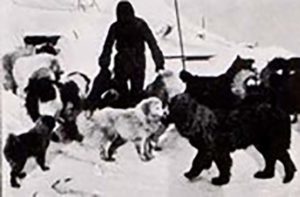 (the majority Ostiaks dogs) but 2 samoyed bitches were obtained at the Khabarova port.Jackson refers to these two bitches as, Sally and Jinnie. He describes his dogs as: ”stout and heavily boned, leggy and wolf like, with coloring of gray to dark brown and having prick ears.” He also found his dogs to be excellent bear dogs—that is polar bear. Jackson did bring back eight dogs from this adventure while many explorers did not. Ernest Kilburn Scott of England acquired Samoyeds from this Jackson expedition.
(the majority Ostiaks dogs) but 2 samoyed bitches were obtained at the Khabarova port.Jackson refers to these two bitches as, Sally and Jinnie. He describes his dogs as: ”stout and heavily boned, leggy and wolf like, with coloring of gray to dark brown and having prick ears.” He also found his dogs to be excellent bear dogs—that is polar bear. Jackson did bring back eight dogs from this adventure while many explorers did not. Ernest Kilburn Scott of England acquired Samoyeds from this Jackson expedition.
The Norwegian C. E. Borchgrevink, on the Southern Cross Expedition, traveled to the Antarctic with 90 dogs which were Greenland dogs and some Samoyeds. He mentions in his book that all 90 dogs were given names by the Finns who were the caretakers of the dogs on the trip. In his book, ”First on the Antarctic Continent”, he mentions that the dogs had a difficult time with the heat on the way south and had dogs die. Another problem the dogs had to contend with is in rough water, they were constantly wet from the high seas, and skin problems became prevalent. He also noted that the dogs were vicious fighters amongst themselves. They would pick out a particular dog to torment and ultimately kill. This was a trait noted by almost all of the explorers. Borchgrevink released dogs on Native Island (adjacent to Stewart Island) with permission from the New Zealand government.
Captain Robert F. Scott, first Antarctic Expedition, on the Discovery took 23 dogs. He originally was not going to use dogs, because he thought they were disgusting because they would eat their own feces but also because they fought amongst themselves so viciously. But he consulted with Nansen who convinced him he should obtain Greenland dog. Because so many expeditions were procuring dogs it was next to impossible to obtain Greenland dogs. Scott’s dogs were picked up in Archangel area of Siberia.
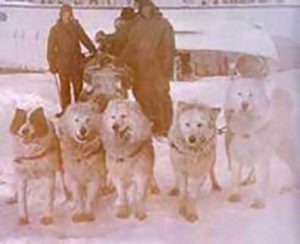 Ernest Shackleton, 1907-1909, also traveled to the Antarctic aboad the Nimrod, with the help of sledge dogs. Shackleton states “I place little reliance on dogs, but I thought it advisable to takes ome of these animals.” He contacted a breeder in Steward Island, New Zealand to obtain his dogs. He was only able to obtain 9 dogs (5 bitches and 4 dogs) that were descendents of the Borchgrevink expedition. But the numbers increased to 22 with the arrival of pups during hiswork in the south. Many pups perished due to lack of care by the mothers and other difficulties with life in the extreme cold. One dog that he describes, Tripp, was “pure white and a fine upstanding beast of a very affectionate disposition”, but also this dog and another, Scamp, that many battles were fought. Another description he has in his book is about at bitch named, Roland. She was a favorite among the men and she would watch for the door to the hut to open, and would launch her furry white body into the men inside the hut! He does mention that all the pups born were white, or would have been white if they had not slept in the warm ashes that were disposed of nightly.
Ernest Shackleton, 1907-1909, also traveled to the Antarctic aboad the Nimrod, with the help of sledge dogs. Shackleton states “I place little reliance on dogs, but I thought it advisable to takes ome of these animals.” He contacted a breeder in Steward Island, New Zealand to obtain his dogs. He was only able to obtain 9 dogs (5 bitches and 4 dogs) that were descendents of the Borchgrevink expedition. But the numbers increased to 22 with the arrival of pups during hiswork in the south. Many pups perished due to lack of care by the mothers and other difficulties with life in the extreme cold. One dog that he describes, Tripp, was “pure white and a fine upstanding beast of a very affectionate disposition”, but also this dog and another, Scamp, that many battles were fought. Another description he has in his book is about at bitch named, Roland. She was a favorite among the men and she would watch for the door to the hut to open, and would launch her furry white body into the men inside the hut! He does mention that all the pups born were white, or would have been white if they had not slept in the warm ashes that were disposed of nightly.
Three of the North Pole expeditions, Nansen, Abruzzi , Jackson, and 2 Antarctic expeditions, Borchgrevink and Shackleton did have dogs that survived. From the literature one can sift through and find some information concerning the fate of these dogs but their fate does not appear important to most writers. Many authors of books on Samoyed history do not tell where they obtain their facts, which makes it difficult to verify information. And once one starts going through the diaries of the explorers one finds discrepancies from what these “Samoyed history authors” claim. An example of this is a dog that appears many times in the literature about the history of Samoyeds dogs: Antarctic Buck. This dog was a descendent of dogs that were on the Southern Cross expedition not an actual sledge dog used in this expedition. Samoyeds dogs are a special breed with a rich history but also with many misleading myths lurking within the history that with constant repetition become the “truth.”
LITERATURE LIST
1. Amedeo, Luigi of Savoy, Duke of Abruzzi, 1902 , vol 1, “On the Polar Star in the Arctic Sea”, Hutchinson and Co., Paternoster Row London
2. Bernacchi, Louis, 1901, “To the South Pole Regions” Bluntisham Books– Erskine Press
3. Borchgrevink, C.E., 1901, “First on the Antarctic Continent” C. Hurst and Company London
4. Caswell, John Edwards 1956, “Arctic Frontiers– United States Explorations in the Far North” Norman: University of Oklahoma Press
5. Donner, Kai, 1954, “ Among The Samoyed in Siberia” Human Relations Area Files, New Haven
- Forsyth, James 1992, “A History of the Peoples of Siberia”, Cambridge University Press, Great Britain
- Golovnev, Andrei V. and G. Osherenko, 1999 “Siberian Survival, The Nenets and Their Story”, Cornell University Press, Ithaca and London
- Jackson, Frederick G., 1899 “A Thousand Days in the Arctic” Harper and Brothers Publishers, New York and London
- Huntford, Roland, 1987 “The Amundsen Photographs” The Atlantic Monthly Press, New York
- Lehtisalo, T. von, 1932 “Beiträge Zur Kenntnis Der Renntierzucht Bei Den Juraksamojeden” H. Aschehoug and Co., Leipzig
- Levin, M. G. and L.P. Potapov, 1956 “The Peoples of Siberia”, The University of Chicago Press, Chicago and London
- Nansen, Fridtjof, 1999 “Farthest North” Abridgement and biographical note, Modern Library Paperback Edition, USA
- Nansen, Fridtjof, 1971 “Through Siberia, The Land of the Future” Arno Press and The New York Times, New York
- Scott, Robert F., 2001 “The Voyage of the Discovery-Scott’s First Antarctic Expedition” unabridged volume 1, Cooper Square Press
- Shackleton, Ernest, 2000 “The Heart of the Antarctic: The Farthest South Expedition” Signet Book, New York
- Wellman, Walter , The Wellman Polar Expedition, The National Geographic Magazine, Vol. X, No. 12, Dec. 1899, p.481-503
- Ziker, John P. 2002 “Peoples of the Tundra. Northern Siberians in the Post-Communist Transition” Waveland Press, Inc. Prospect Heights, Illinois
